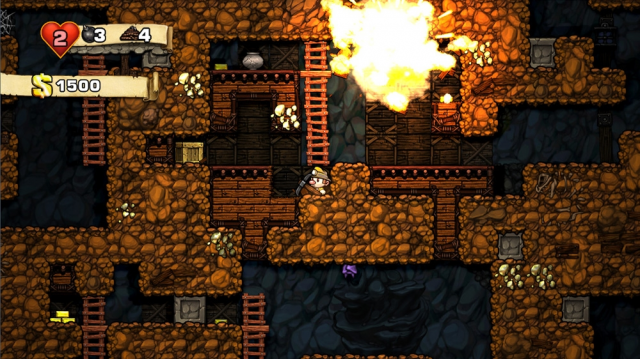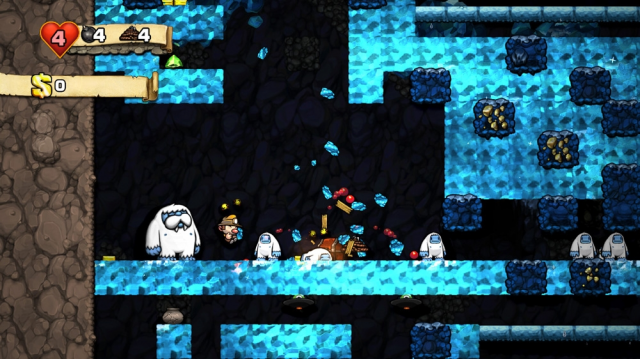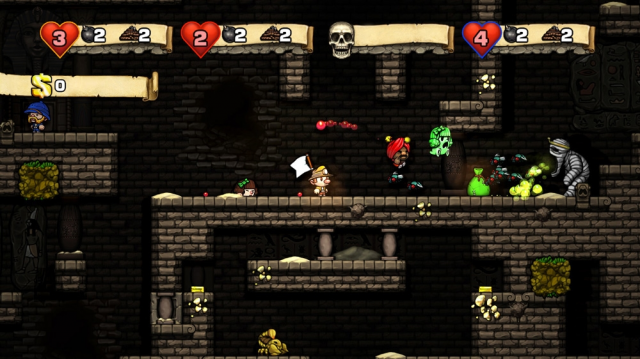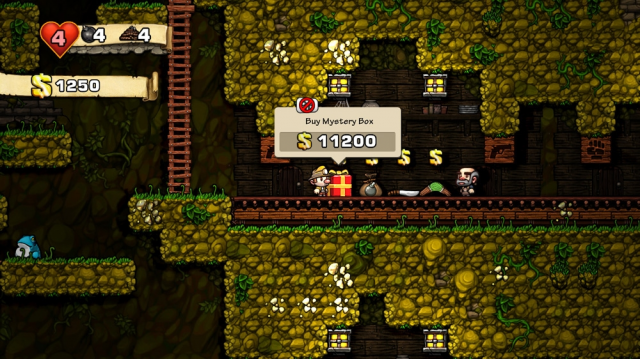Spelunky review (XBLA)
Spelunky was developed by Mossmouth and was published by Microsoft Studios. It was released on July 4, 2012 and retails for 1200 MSP. A copy was provided for review purposes.
Spelunky casts you as a nameless adventurer seeking treasure in a deep cave. Blocking you from your bounty are countless enemies, traps, and other hazards. The way you choose to tackle these challenges really defines how the game will play for you. Some may crash ahead fearlessly while others will be more cautious. Spelunky is technically an action/platformer, but it also has roguelike qualities as well. You run and jump, whip and shoot. What’s surprising is to learn that death is permanent here and one false move sends you back to the very beginning. It’s a truly unique game and is presented in a very attractive manner. It does everything it sets out to do, even when it’s rejecting modern gaming conventions.
Here’s what we liked:
Cute visuals – Spelunky’s look has come a long way from its PC predecessor. In truth we love the old style 8-bit look of the original. But the HD upgrade looks great. All the characters and enemies are well animated. Their cute look belies the cruel nature of this game though. Regardless there is a great deal of character in the sprites and the entire world in general. It’s a fun game just to look at. And who doesn’t love a cute little fedora wearing, whip wielding, treasure hunting cave explorer?
Tight control – It’s a fact, no platformer can succeed without tight controls. Thankfully Spelunky gives us exactly what we need in this field. That isn’t to say that it is easy to run all over with your chosen character. The walk seems a bit slow and the run a bit fast. The whip takes a fair amount of practice to time consistently. But none of it feels wrong. It’s just a matter of learning your abilities and limitations. The controls are always spot on.
Varied gameplay – Spelunky can be played many ways. You have to decide your strategy because indecision is sure to get you killed. Initially you need to decide on loot, speed, or safety. It’s rare to have two of those at the same time. Going for all the treasure is very tempting, but could also be very dangerous. At the same time going very slowly and carefully could take too long and cause a ghost to hunt you down. You can run straight for the exit but then have no money to buy upgrades. Everything is a constant risk-vs-reward question. Death is a big deal because it ends the game. Additionally health is not easy to come by, so taking even one hit from an enemy is significant. Each encounter must be thought out and executed properly. Even choices with money will have drastic effects on your outcome. Should you spend your money now, or save it for something later? Experts won’t spend their money at all because they want to achieve the high score. Stealing is an ill advised tactic only for the most desperate. The point is there are a great deal of strategies and scenarios. You have to decide the best way of handling it with limited resources while in real danger.
Infinite levels – Procedural generation is a term that gets thrown around a lot these days. For our purposes it refers to the game itself randomly making a new level each time you play. The result is that you never play the same game twice. We have played some games with some pretty poor procedural generated levels. Thankfully Spelunky is not one of them. Smart level design is pervasive each time you play. Enemies are situated in a way that feels devious, not cheap or stupid. Items you find make sense in the context of the level. This variety changes the whole tone of the game. Most gamers are accustomed to memorizing difficult levels as a means of clearing them, but that won’t work here. You must learn skills that will allow you to survive any encounter. This is one of Spelunky’s most compelling features.
Exploration and learning – Very little is explained. The tutorial prompts you to perform the basic movements of the game, then you’re left to fend for yourself. Interestingly the opening montage for the tutorial tells the story of another explorer who is bewildered and frustrated. But he learns little by little, death after death and eventually overcomes all the obstacles. Playing Spelunky feels very much like that. You constantly die and you slowly realize how to overcome it.
Here’s what we didn’t like:
Too hard – Bringing a robust challenge to the table is great. But Spelunky takes it to the next level. It is comparable in base difficulty to Super Meat Boy or Aban Hawkins and the 1000 Spikes. But in those games after you die you go back and try the same obstacle again until you overcome it. In Spelunky you have to overcome everything the first time (remember the procedural generated levels) or die. It really is amazing how quickly things can go south, too. A great run is completely ruined so easily. One bad encounter with an enemy, one misplaced bomb, or one bad jump and death comes oh so quickly. It’s truly a difficult game, even on the first level. You can rise above, but it takes tenacity and skill to overcome it.
Old School – Most gamers no longer fear death. Fez is a fine example. Making a bad jump is no big deal at all. The game literally saves every three seconds or so. If you die you are instantly send back to your last location with no consequences. Spelunky takes a different approach. If you die for any reason you go back to level 1-1. There are no checkpoints, no extra lives, nothing. You will be spending a lot of time in level 1-1. In fairness, with a great deal of effort shortcuts can be opened to other levels. But using them disqualifies you from any high score on the leaderboards so it’s really a glorified practice mode. This really kills the feeling of progression. This sort of hardcore gameplay has a niche following for sure, but is is awfully alienating to everyone else.
Inaccessible – We honestly question how many gamers will do what it takes to beat level one before giving up. The game has so much to offer but the content is all locked behind its daunting difficulty. The bar is set awfully high for the average gamer to get there money’s worth here.
Price – The actual value or worth of a game is a sticky issue. The proliferation of the 1200 MSP game and the seeming disappearance of the 400 MSP game are issues we have all heard about before. It seems to us that Spelunky is priced too high when you consider how difficult it will be to actually access all of its content.
Taken on its own merits Spelunky is a tremendous package. The visuals are great and the gameplay is refined. The procedural generation of levels gives it essentially infinite replay value. It has old school sensibilities which are very popular right now. It’s an easy game to lavish praises on, but still a tough game to recommend. Mossmouth made specific choices with this game and ultimately they are somewhat alienating to a lot of the gaming public. For better or worse gamers expect character progression, checkpoints, and extra lives. Despite Spelunky’s brilliance it’s likely not geared towards many gamers today. Play the demo and see it for yourselves.
Score: Try It





